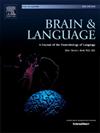Language mixing in people with aphasia: A cross-linguistic analysis using the 4M model
IF 2.3
2区 心理学
Q1 AUDIOLOGY & SPEECH-LANGUAGE PATHOLOGY
引用次数: 0
Abstract
Language mixing (LM) is common among individuals who speak two or more languages. LM in healthy multilingual individuals has been studied extensively, often by applying the Matrix Language Frame (MLF) and the 4M model, both developed by Myers-Scotton and colleagues. Our study examined LM in multilingual people with aphasia (PWA), to determine: (1) frequency of LM in the first-acquired language (L1) and later-acquired languages (L2/L3); (2) whether the 4M model accounts for LM patterns; and (3) how language-specific characteristics affect LM.
Narratives produced by 18 multilingual PWA (English-Hebrew; English-Spanish, English-Hebrew-Spanish and Russian-Hebrew speakers) with and without agrammatism were analyzed using the 4M model. More LM was observed in L2 contexts compared to L1 in participants with agrammatism, yet in participants without agrammatism no differences were found between L1 and L2. The patterns of LM in target and non-target languages were similar across L1 and L2: content morphemes were more likely to be embedded into the matrix language, aligning with previous research on healthy multilingual controls. Differences were found between the types of LM across the four studied languages.
Our findings indicate that multilingual PWA mix languages in a typical manner, similar to neurotypical multilingual individuals, aligning with the predictions of the 4M model. Furthermore, in multilingual PWA, as in healthy multilingual people, differences in LM across languages are related to the morphological richness of the matrix language and the congruency of the languages involved in LM. Clinically, based on our results, LM can be encouraged as a communication aid.
失语症患者的语言混合:使用4M模型的跨语言分析
语言混合(LM)在讲两种或两种以上语言的个体中很常见。健康的多语言个体的语言学习已经得到了广泛的研究,通常是通过使用矩阵语言框架(MLF)和4M模型,这两种模型都是由Myers-Scotton及其同事开发的。本研究对多语失语症患者(PWA)的LM进行了检测,以确定:(1)在第一习得语言(L1)和后习得语言(L2/L3)中LM的频率;(2) 4M模型是否考虑了LM模式;(3)语言特征对LM的影响。由18个多语种PWA(英语-希伯来语;使用4M模型对英语-西班牙语、英语-希伯来语-西班牙语和俄语-希伯来语使用者进行了分析。在有语法障碍的参与者中,L2语境中的LM比L1语境中更多,而在没有语法障碍的参与者中,L1语境和L2语境之间没有差异。目标语言和非目标语言的LM模式在第一语言和第二语言中相似:内容语素更有可能嵌入到矩阵语言中,这与先前关于健康多语言对照的研究一致。在四种被研究的语言中,LM的类型存在差异。我们的研究结果表明,多语言PWA以典型的方式混合语言,类似于神经典型的多语言个体,与4M模型的预测一致。此外,在多语PWA中,与健康的多语人群一样,不同语言的LM差异与矩阵语言的形态学丰富度和LM中涉及的语言的一致性有关。在临床上,根据我们的结果,LM可以作为一种交流辅助工具加以鼓励。
本文章由计算机程序翻译,如有差异,请以英文原文为准。
求助全文
约1分钟内获得全文
求助全文
来源期刊

Brain and Language
医学-神经科学
CiteScore
4.50
自引率
8.00%
发文量
82
审稿时长
20.5 weeks
期刊介绍:
An interdisciplinary journal, Brain and Language publishes articles that elucidate the complex relationships among language, brain, and behavior. The journal covers the large variety of modern techniques in cognitive neuroscience, including functional and structural brain imaging, electrophysiology, cellular and molecular neurobiology, genetics, lesion-based approaches, and computational modeling. All articles must relate to human language and be relevant to the understanding of its neurobiological and neurocognitive bases. Published articles in the journal are expected to have significant theoretical novelty and/or practical implications, and use perspectives and methods from psychology, linguistics, and neuroscience along with brain data and brain measures.
 求助内容:
求助内容: 应助结果提醒方式:
应助结果提醒方式:


